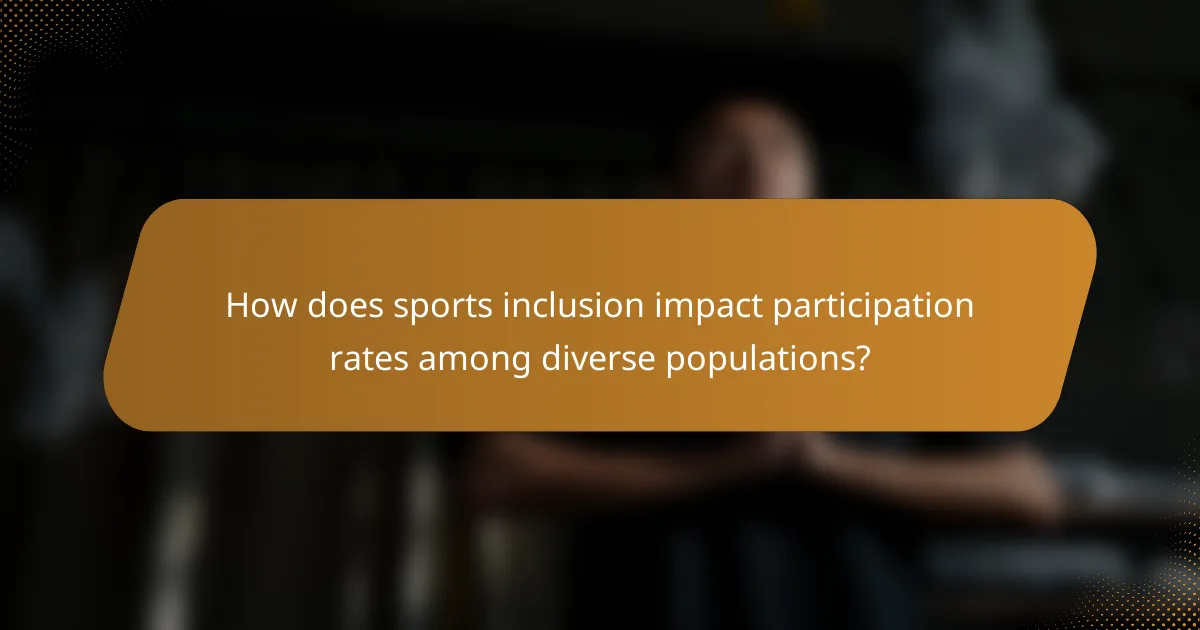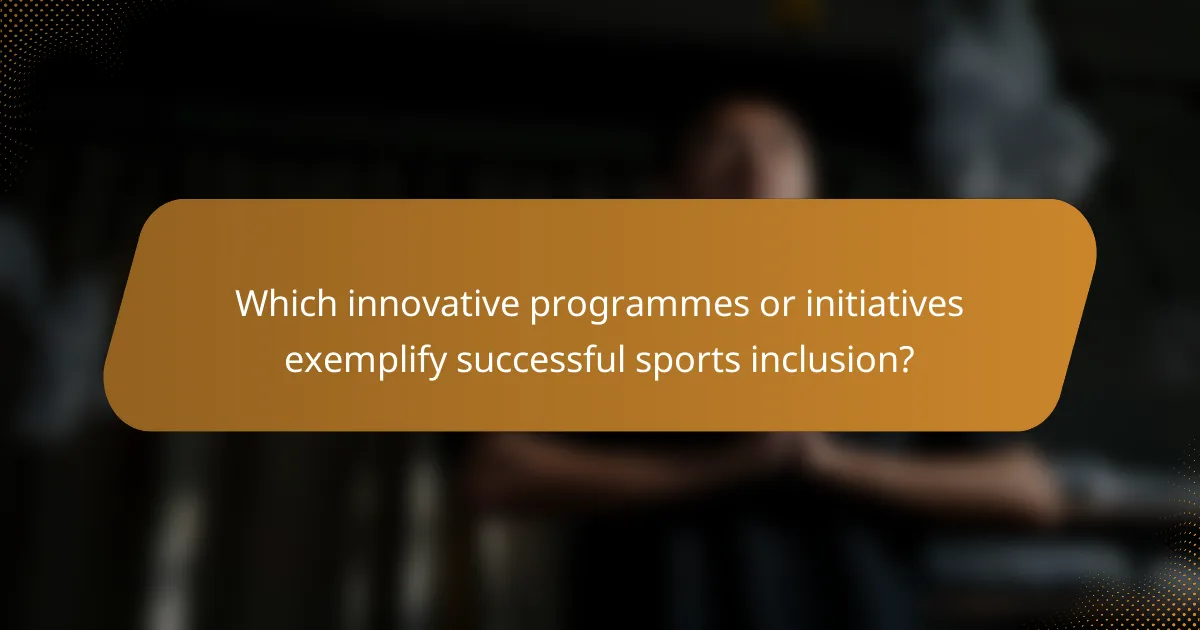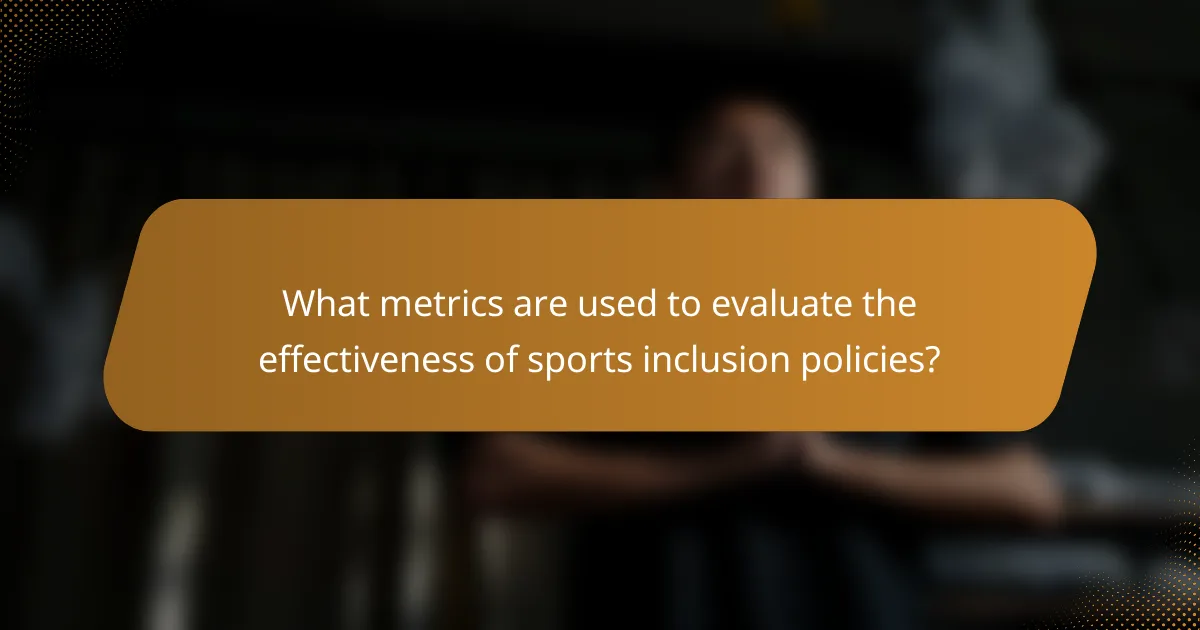Sports inclusion enhances community engagement and participation, addressing barriers faced by diverse groups. Key policies focus on accessibility, funding, and education to promote involvement. Successful initiatives like the Special Olympics and Paralympic Games exemplify the positive impact on social cohesion and well-being. Metrics such as participation rates and demographic diversity evaluate the effectiveness of these inclusive strategies.

What are the key policies driving sports inclusion in communities?
Key policies driving sports inclusion in communities focus on accessibility, funding, and education. These policies aim to eliminate barriers and promote participation among diverse groups. For example, local governments often implement grants for adaptive sports programmes, enhancing participation rates. Community engagement initiatives also foster awareness and support for inclusive practices. Additionally, partnerships with organisations dedicated to disability rights ensure that programmes meet the needs of all participants. Such policies ultimately lead to stronger, more cohesive communities.
How do these policies vary across different regions?
Sports inclusion policies vary significantly across regions, reflecting local cultural values and resources. In some areas, inclusive sports programmes receive substantial government support, while others rely on grassroots initiatives.
For example, Nordic countries emphasise accessibility and funding, resulting in high participation rates. In contrast, regions with limited resources may struggle to implement effective policies, leading to lower community engagement.
Additionally, urban areas often have more structured inclusion policies compared to rural regions, where access to facilities and programmes is more challenging.
As a result, the effectiveness of sports inclusion policies is closely tied to regional priorities and available support systems.
What role do governmental and non-governmental organizations play?
Governmental and non-governmental organisations significantly enhance sports inclusion by creating policies, providing funding, and fostering community engagement. These entities advocate for equitable access to sports, ensuring diverse participation across various demographics.
Governmental organisations often establish regulations that mandate inclusion, while non-governmental organisations typically focus on grassroots initiatives and awareness campaigns. For example, initiatives like “Sport for All” promote participation among underrepresented groups, demonstrating the impact of collaborative efforts.
The community benefits from these initiatives through improved health outcomes, social cohesion, and increased opportunities for personal development. Research indicates that inclusive sports programmes can reduce barriers and enhance the quality of life for participants.
In summary, both governmental and non-governmental organisations play essential roles in advancing sports inclusion, driving policy changes, and creating supportive environments that empower individuals and communities.

How does sports inclusion impact participation rates among diverse populations?
Sports inclusion significantly enhances participation rates among diverse populations by fostering a sense of belonging and community. Inclusive policies create environments where individuals feel valued and supported, leading to increased engagement in sports activities. Research indicates that communities with inclusive sports programmes see a rise in participation rates, particularly among underrepresented groups. For instance, a study found that inclusive initiatives can boost participation by up to 30% among marginalised populations. Consequently, sports inclusion not only promotes physical activity but also strengthens social cohesion and community ties.
Which demographics benefit most from inclusive sports programmes?
Individuals with disabilities, youth, and marginalised communities benefit most from inclusive sports programmes. These programmes promote participation, foster social integration, and enhance physical and mental well-being.
Research indicates that inclusive sports initiatives improve self-esteem and community cohesion. For example, youth from diverse backgrounds report increased engagement in physical activities, leading to healthier lifestyles. Additionally, inclusive programmes often provide tailored support, ensuring that all participants can access resources and opportunities.
Engaging individuals with disabilities in sports can lead to enhanced social skills and reduced stigma. As a result, communities experience greater unity and understanding, promoting a culture of acceptance and support.
Overall, inclusive sports programmes serve as a vital tool for enhancing the quality of life across various demographics, contributing positively to individual and community health.
What barriers exist to participation in inclusive sports?
Barriers to participation in inclusive sports include lack of access, insufficient funding, and limited awareness. Physical and attitudinal obstacles also hinder engagement. For example, inadequate facilities may not accommodate individuals with disabilities. Additionally, societal stigma can discourage participation, impacting community integration.

What are the community benefits of promoting sports inclusion?
Promoting sports inclusion provides numerous community benefits, such as enhanced social cohesion, increased physical activity, and improved mental health. These benefits foster a sense of belonging and encourage diverse participation. Sports inclusion policies can lead to greater accessibility, allowing individuals from various backgrounds to engage in physical activities. As a result, communities experience lower rates of social isolation and improved overall well-being.
How does sports inclusion foster social cohesion?
Sports inclusion fosters social cohesion by promoting interaction among diverse groups. It encourages teamwork, understanding, and mutual respect. Inclusive sports programmes reduce social barriers and foster community identity. Research shows that communities with active sports inclusion initiatives experience lower crime rates and higher civic engagement, enhancing overall well-being.
What economic impacts arise from increased participation in inclusive sports?
Increased participation in inclusive sports leads to significant economic benefits for communities. It stimulates local economies through job creation and increased spending on sports facilities and events. Additionally, inclusive sports foster social cohesion, enhancing community well-being and reducing healthcare costs. As a result, cities that promote inclusive sports often experience growth in tourism and local business revenues.

Which innovative programmes or initiatives exemplify successful sports inclusion?
Innovative programmes exemplifying successful sports inclusion include initiatives like the Special Olympics, Paralympic Games, and community-based adaptive sports programmes. These initiatives enhance participation and foster community engagement. Special Olympics provides athletes with intellectual disabilities opportunities to compete, promoting social inclusion. Paralympic Games empower athletes with physical disabilities, showcasing their capabilities globally. Community-based adaptive sports programmes offer tailored activities, ensuring accessibility for all, thus enhancing local engagement and participation.
What unique approaches have been adopted in various communities?
Various communities have adopted unique approaches to sports inclusion, emphasizing accessibility and participation. For instance, adaptive sports programmes offer tailored training and competition opportunities for individuals with disabilities.
Community partnerships enhance outreach and create inclusive events, fostering a sense of belonging. Some regions implement policies that mandate accessible facilities, ensuring everyone can participate in sports activities.
Additionally, awareness campaigns educate the public on the benefits of inclusion, promoting diverse participation. These strategies collectively strengthen community bonds and enhance overall well-being.
How do technology and social media enhance sports inclusion efforts?
Technology and social media significantly enhance sports inclusion efforts by fostering community engagement and accessibility. Digital platforms provide opportunities for underrepresented groups to participate in sports activities. For instance, live streaming events and virtual training sessions enable broader access, breaking geographical barriers. Social media campaigns raise awareness, promote inclusive policies, and connect diverse athletes, amplifying their voices. These tools also facilitate collaboration among organisations, driving initiatives that support marginalised communities in sports. By leveraging technology, the sports industry can create a more inclusive environment that benefits everyone.

What metrics are used to evaluate the effectiveness of sports inclusion policies?
Metrics used to evaluate the effectiveness of sports inclusion policies include participation rates, demographic diversity, community engagement, accessibility measures, and satisfaction surveys. These metrics assess how well policies promote inclusivity and enhance overall community benefits.
| Metric | Description |
|————————–|———————————————————–|
| Participation Rates | Percentage of underrepresented groups in sports activities |
| Demographic Diversity | Variety of backgrounds among participants |
| Community Engagement | Level of local involvement in sports programmes |
| Accessibility Measures | Availability of facilities and resources for all abilities |
| Satisfaction Surveys | Feedback from participants regarding their experiences |
How can communities measure participation and engagement?
Communities can measure participation and engagement through surveys, attendance tracking, and feedback mechanisms. These methods provide quantitative and qualitative data on community involvement in sports programmes. Surveys can assess participant satisfaction and identify barriers to engagement. Attendance tracking offers insights into the frequency and demographics of participants. Feedback mechanisms allow for ongoing dialogue, fostering a sense of inclusion and responsiveness. Collectively, these strategies enhance understanding of community dynamics and inform policies to boost sports inclusion.
What are the indicators of success in inclusive sports programmes?
Indicators of success in inclusive sports programmes include increased participation rates, enhanced community engagement, and improved athlete performance. These metrics reflect the programme’s effectiveness in fostering an environment where individuals of all abilities can thrive.
Participation rates show how well the programme attracts diverse groups. Community engagement highlights the programme’s ability to connect with local organisations and stakeholders. Improved athlete performance indicates that participants gain skills and confidence through inclusive practices.
Additionally, feedback from participants and families provides qualitative insights into the programme’s impact. Tracking these indicators helps ensure continuous improvement and sustainability.
What common mistakes should organizations avoid when implementing inclusion policies?
Organisations should avoid common mistakes like lack of stakeholder engagement, unclear objectives, and insufficient training. Engaging all stakeholders fosters ownership and commitment, while clear objectives ensure alignment. Additionally, training staff on inclusion policies enhances understanding and implementation. These practices lead to more effective sports inclusion policies and greater community benefits.
What expert tips can enhance the effectiveness of sports inclusion initiatives?
Implementing expert tips can significantly enhance the effectiveness of sports inclusion initiatives. Focus on community engagement, ensuring diverse voices contribute to programme design.
Establish clear policies that promote accessibility and participation across all demographics. Regularly evaluate the impact of initiatives through participant feedback and participation metrics. Collaborate with local organisations to foster a supportive environment and increase resource availability. Lastly, provide training for staff and volunteers to cultivate an inclusive culture within sports programmes.
